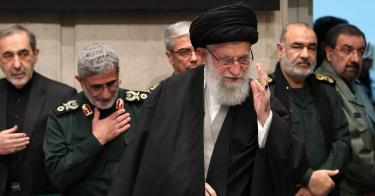Tensions between the United States and Iran, boiling after the U.S. killed Gen. Qassem Suleimani on Jan. 3, have now returned to a simmer. Tehran’s ineffective response seems calibrated to avoid a damaging reprisal. But Tehran’s reluctance to risk further open hostilities suggests that it will return to its old playbook of asymmetric, indirect attacks against the U.S. The sweet spot for Iran is an attack that wounds the U.S. but has enough murkiness around ultimate responsibility that the Trump administration would struggle to justify a vigorous response.
Africa could be the site of such an attempted revenge tour.
Thanks to recent efforts by its Middle Eastern rivals, Iran has lost some of the influence it began building across Africa almost immediately after the 1979 revolution. Tehran’s networks still weave across parts of the continent, however, offering options that it could tap for an attack.
Hezbollah, Tehran’s most formidable terrorist proxy, smuggles everything from drugs to people through West Africa. Major Hezbollah funders have business empires stretching into multiple African countries.
Moreover, Iranian proselytization in countries such as Senegal and Sudan has created Shiite communities which, though usually small, likely contain some devotees willing to take Iranian orders. The founders of an influential, Iranian-backed Shiite organization in northern Nigeria, in fact, hoped to foment in their own country a revolution like Iran’s.
Before Suleimani’s death, the Quds Force he headed was reportedly creating new African capabilities for retaliating against the Trump administration’s “maximum pressure” campaign. Suleimani established terror cells designed to hit U.S. and other Western targets on the continent.
Suleimani’s death could slow this plan, but his successor, Esmail Qaani, reportedly ran the Quds Force’s Africa operations previously, suggesting he could seamlessly continue Suleimanis project. Iran has also used Africa before: Kenyan authorities have arrested Iranians for involvement in two separate terror plots against Israeli targets in Kenya, so operations there would be a return to familiar territory.
Surely, Tehran recognizes that Africa is one of the easiest regions in the world in which to launch a deniable attack. African terrorist groups have proliferated recently, giving Iran plenty of choice if it seeks a partner to serve as the face of an attack.
Nearly all African terrorists are Sunni and not natural allies for Shiite Iran, yet Tehran and al Qaeda have previously embraced ecumenicism long enough to cooperate against “the great Satan.” Iran and Hezbollah helped al Qaeda launch the devastating 1998 bombings of the U.S. embassies in Tanzania and Kenya, and reportedly had links to the Islamic Courts Union and its successor, al Shabaab, which are both Sunni terrorist organizations from Somalia.
The U.S.'s surveillance and intelligence capabilities are also more thinly stretched in Africa than in the Middle East, and a rumored drawdown of U.S. military personnel in Africa would heighten the challenge of defending against an Iranian plot on a continent three times larger than the Middle East.
There is, as well, a staggering amount of illicit activity in Africa; informal cross-border trade accounts for more than 40% of the continent’s GDP, for example. This creates enough “noise” to cloak terrorist undertakings.
The incapacity of many African governments hobbles their ability to disrupt terror activity on their soil; by one measure, 18 of the world’s 25 most fragile states are African. And the great cancer of many African countries, corruption, has already made terrorists’ jobs far easier there.
Africa has no shortage of potential U.S. targets for an Iranian-backed attack. For instance, thousands of U.S. aid workers operate on the continent, often in remote and insecure areas. In fact, terrorists already frequently target aid workers.
Even the U.S. military presence in Africa has been vulnerable at times, as shown by the recent terrorist attack on a joint U.S.-Kenya military base that killed three Americans. Last year, the U.S. had 29 military sites on the continent, though not all of them are manned full time.
The Trump administration’s killing of Suleimani has made Iran wary of openly provoking the U.S., but it is not going to abandon four decades of hell-raising now. Tehran may decide that Africa, sprinkled with Iranian networks, burdened with swathes of territory ungoverned by any legitimate authority, and target-rich, is just the right place for a series of deniable, asymmetric attacks against U.S. interests there.
This piece originally appeared in Washington Examiner



